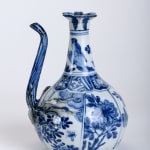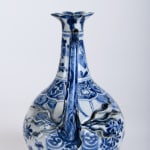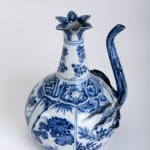A CHINESE EXPORT BLUE & WHITE 'POMEGRANATE' CRUET
D: 15” / 40cm
Further images
Provenance
Jorge Welsh, Lisbon
Private Collection: Lisbon, Portugal
Exhibitions
Examples of this form of ewer can be found in the below:
Princessehof Museum in Leeuwarden (inv. no. 2501)
Groninger Museum in Groningen (inv. no. 1960-57-B)
Bell Collection at the Gardiner Museum of Ceramic Art in Toronto (inv. no. G99.1.7)
British Museum in London (inv. no. OA F.1579)
Musée Guimet (Grandidier Collection, inv. no. G. 1005)
F. Lugt Collection at the Fondation Custodia, Institut Néerlandais (inv. no. 7437)
Literature
Rinaldi, M., Kraak Porcelain: A Moment in the History of the Trade (London, 1989), pp. 177-9, esp. fig. 228
Welsh, J., Kraak Porcelain: The Rise of Global Trade in the Late 16th and Early 17th Centuries (Lisbon & London, 2008), pp. 176-9, 262-3
Of pomegranate form, finely painted with panels of ruyi heads, key fret, water plants, insects, bamboo shoots and sprays of blossoming flowers in contrasting shades of bright underglaze cobalt-blue, the serpentine spout issuing leaves moulded in relief and the tapering neck with a bird atop a rock ending in a six-point ‘pomegranate’ star, made for the Middle Eastern or European market following earlier Islamic forms in metal.
This example is a particularly elegant shape and potted very finely, in contrast to thicker kendis. It is part of a special group of kraak pouring vessels that first appeared in the reign of Emperor Wanli, other examples of which are in the Franks Collection in the British Museum, the Lady Lever Art Gallery and the Fondation Custodia, Institut Néerlandais (Rinaldi, Kraak Porcelain, 1989, pl. 228), to the latter of which the present example bears particular close relation in both form and decoration.
Known as a ‘pomegranate ewer’, owing to the globular body and star-shape mouth, in Chinese culture the pomegranate (shi-liu) symbolises rejuvenation, abundance and a blessed future. Finley painted throughout with blooms and auspicious motifs, the ewer is also symbol of prosperity and good fortune.







